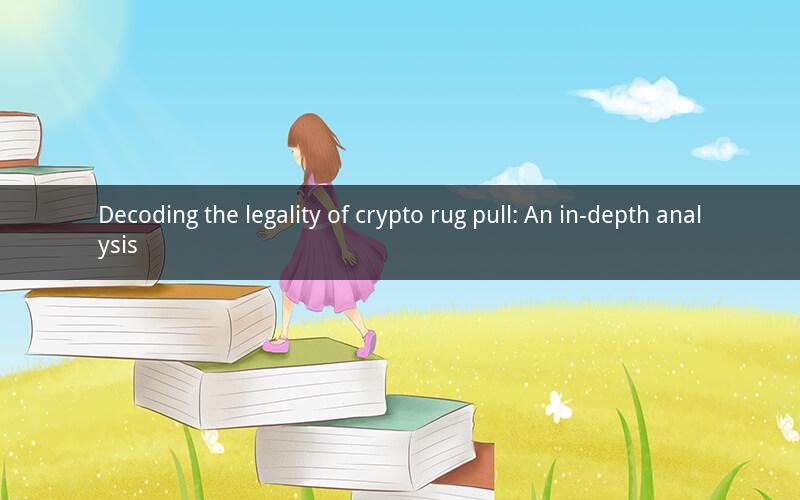
The rise of cryptocurrencies has brought with it a myriad of opportunities and challenges. One such challenge is the emergence of rug pulls, which have left many investors disillusioned and questioning the legality of such practices. In this article, we will explore the concept of rug pull in the crypto space and whether it is illegal.
Rug pull refers to a fraudulent activity where a project founder or team suddenly removes the value of the project's token, often leaving investors with nothing but a worthless asset. The term "rug" is derived from the idea that the rug is pulled out from underneath investors, leaving them exposed to losses.
The legality of rug pull is a complex issue, as it varies from country to country and depends on several factors. In some jurisdictions, rug pull is considered illegal, while in others, it is not. This article will examine the legality of rug pull in different countries and shed light on the underlying factors that contribute to its legality or illegality.
In the United States, rug pull is generally considered illegal under securities laws. The Securities and Exchange Commission (SEC) has taken a firm stance against such practices, stating that they can be classified as securities fraud. According to the SEC, a rug pull can be deemed a fraudulent scheme if it involves the sale of securities, such as tokens, to investors without proper disclosure or registration.
In Europe, the situation is similar. The European Securities and Markets Authority (ESMA) has warned against rug pull and has advised investors to be cautious when dealing with cryptocurrency projects. While rug pull is not explicitly illegal in Europe, it can be classified as securities fraud under certain circumstances.
In Asia, the legality of rug pull varies from country to country. In Japan, for instance, rug pull is considered illegal under the Financial Instruments and Exchange Act, which prohibits fraudulent activities related to financial instruments. In South Korea, rug pull is not explicitly illegal, but authorities have been cracking down on fraudulent crypto projects.
Now that we have a basic understanding of the legality of rug pull in different countries, let's delve deeper into the factors that contribute to its legality or illegality.
1. Jurisdiction: The legality of rug pull depends on the jurisdiction in which the fraudulent activity takes place. Countries with stringent securities laws are more likely to classify rug pull as illegal.
2. Securities laws: Rug pull can be considered a fraudulent scheme if it involves the sale of securities without proper disclosure or registration. The interpretation of securities laws varies from country to country, which affects the legality of rug pull.
3. Token classification: The classification of a cryptocurrency token plays a crucial role in determining the legality of rug pull. If a token is deemed a security, rug pull can be considered illegal. However, if a token is classified as a utility token or a non-security, rug pull may not be illegal.
4. Regulatory bodies: The role of regulatory bodies in monitoring and enforcing securities laws is essential in determining the legality of rug pull. Countries with active regulatory bodies are more likely to crack down on fraudulent activities, making rug pull less prevalent.
5. Investor protection: The primary objective of securities laws is to protect investors from fraudulent schemes. The level of investor protection in a country can influence the legality of rug pull, as governments are more likely to enforce securities laws if they prioritize investor interests.
In conclusion, the legality of rug pull in the crypto space is a multifaceted issue that depends on several factors, including jurisdiction, securities laws, token classification, regulatory bodies, and investor protection. While rug pull is generally considered illegal in countries with stringent securities laws, the situation can vary significantly across different jurisdictions.
Here are five related questions and their answers:
1. Question: Can rug pull be classified as a Ponzi scheme?
Answer: Yes, rug pull can be classified as a Ponzi scheme if it involves the promise of high returns without a legitimate business model and relies on the investment of new investors to pay off earlier investors.
2. Question: How can investors protect themselves from rug pull?
Answer: Investors can protect themselves from rug pull by conducting thorough due diligence on the project, including researching the team, business model, and tokenomics. They should also be cautious of projects that promise unrealistic returns or lack transparency.
3. Question: Can rug pull be prosecuted as a criminal offense?
Answer: Yes, rug pull can be prosecuted as a criminal offense if it involves fraudulent activities, such as securities fraud or money laundering. The severity of the offense and the jurisdiction's legal framework will determine the potential criminal charges.
4. Question: Are all rug pulls illegal?
Answer: Not necessarily. The legality of rug pull depends on the specific circumstances, such as the classification of the token and the jurisdiction in which the fraudulent activity occurs. In some cases, rug pull may not be illegal, particularly if the token is not classified as a security.
5. Question: What is the role of regulatory bodies in preventing rug pull?
Answer: Regulatory bodies play a crucial role in preventing rug pull by enforcing securities laws, providing investor education, and conducting investigations into fraudulent activities. They can also impose sanctions on individuals or entities involved in rug pull to deter future occurrences.